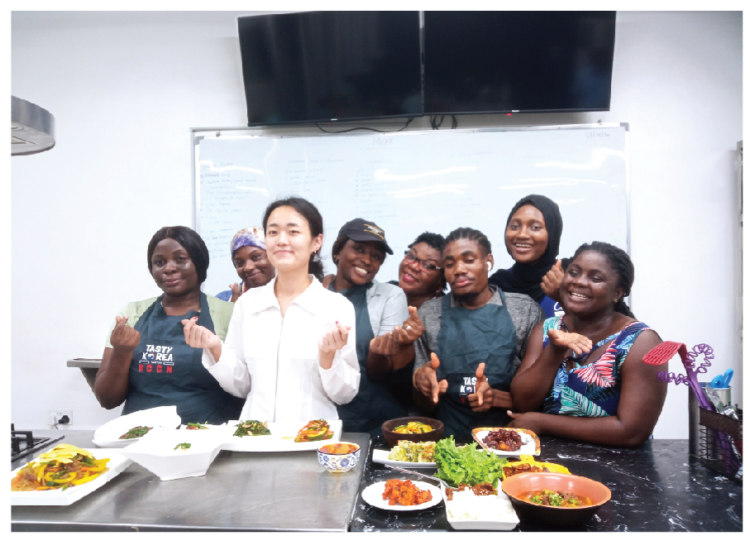As the Korea Food Contest enters its final round, the nine, last-standing contestants are mastering the art of the side dish.
Although the side dish is not a regular feature in many Nigerian homes, it is a relevant accompaniment of main meals in European and Asian countries, particularly in Japan, Indonesia and Korea; and will feature conspicuously in the last round of the competition. Hence, a second tester class organized by the Korea Culture Center Nigeria (KCCN) to prepare contestants for a grand finale that demands their making a full course meal – the main meal based on the ‘Jang’ (Korean sauce), and a Korean side dish.
“In Korean culture, there is a food and side dishes. This class is about giving contestants the experience of making food with side dishes. Korean side dishes include ‘Japchae’ and ‘Gyeran Mari’ (fried eggs). They are experiencing Korean food and side dish culture,” said Korean Cooking Class Supervisor, Sharon Pwavi.
As observed in the previous tester class, some of the contestants’ plan on re-featuring the side dishes tried out in the class. Others are trying out Korean main meals and side dishes for the very first time, and have not quite decided on what to present come Saturday, August 31.
One thing they have in common is – they are unafraid to go big or go home.
Hauwa Ibrahim who made the simplest cuisine for the day, ‘Bulgogi’ (Korean Barbecue), pan-grilled meat paired with white rice, believes her creativity and inclusion of side dishes got her through the first to the final round of the contest.
“I think it’s because in the first round, I took into account the general Korean dining etiquette by making side dishes that incorporated the Jang culture. It was like a full meal rather than just one dish. In the second round, I got really creative with the dishes. I believe it was creativity that got me this far.”
Patience Berepele, Francis Anna Apona, Victor M. Ogagaoghene went big in their full course meal preparation.
Berepele, the only mother in the competition who also made it to the finale, opted for Ssambap (White Rice and ‘Bulgogi’ Wrapped in Lettuce), alongside ‘SsamJang’ Korean stew, and two side dishes.
Ogagaoghene focused solely on side dishes like ‘Oi Muchim’ (Cucumber Salad) and ‘Gyeran Mari’ (Korean Rolled Omelet), either of which he intends to accompany his main dish at the finale.
“I made ‘Japchae’ because it is a popular dish. In the second round of the competition which required fusion cuisine I incorporated local tofu, fruits and vegetables, and substituted pork for beef. I think I was the only one who went for pork over beef.”
Cynthia Madubueze aims to present Rice with ‘Dakbokkeumtang’, alongside side dishes of ‘Oi Muchim’ (Cucumber Salad), seasoned spinach, ‘Gyeran Mari’ and stir-fried zucchini. Talk about a lot. But Francis A. Apona is no different. She made ‘Japchae’, alongside braised tofu, spinach salad, ‘Oi Muchim’, and beans sprout salad. Interestingly, she isn’t overwhelmed and intends to feature all five side dishes at the final round. “I am used to making ‘Japchae’ at this point, that it’s just a flex,” shrugged Anna.
To help contestants maximize time, of which they have only an hour on D-Day to cool, clean and present their dishes, Pwavi recommends prepping first and stir-frying.
“Korean cooking is all about prepping and stir-frying. If you are able to understand your meal prep process and then you stir-fry, the rest is just to mix them up and you are good to go. You can breakdown the process that way. Do your cutting on one side, stir-frying on the other, and mix. I hope they are able to understand the tips and tricks to do their cooking better,” offered Pwavi.





